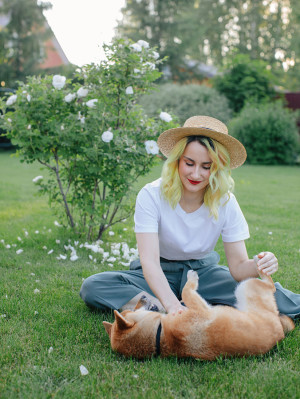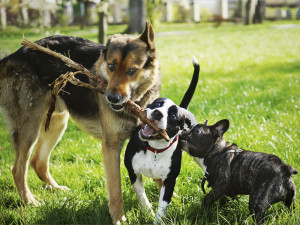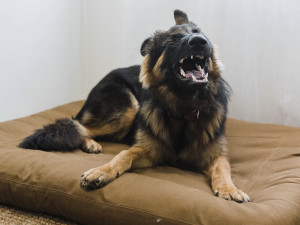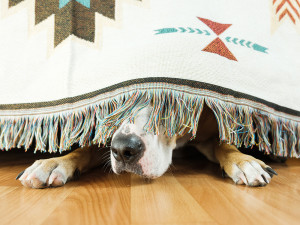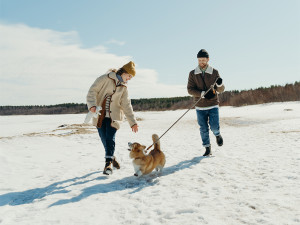How to Help an Anxious Dog Conquer Their Fears
Six animal behaviourists share pro tips for boosting the confidence of a fearful dog
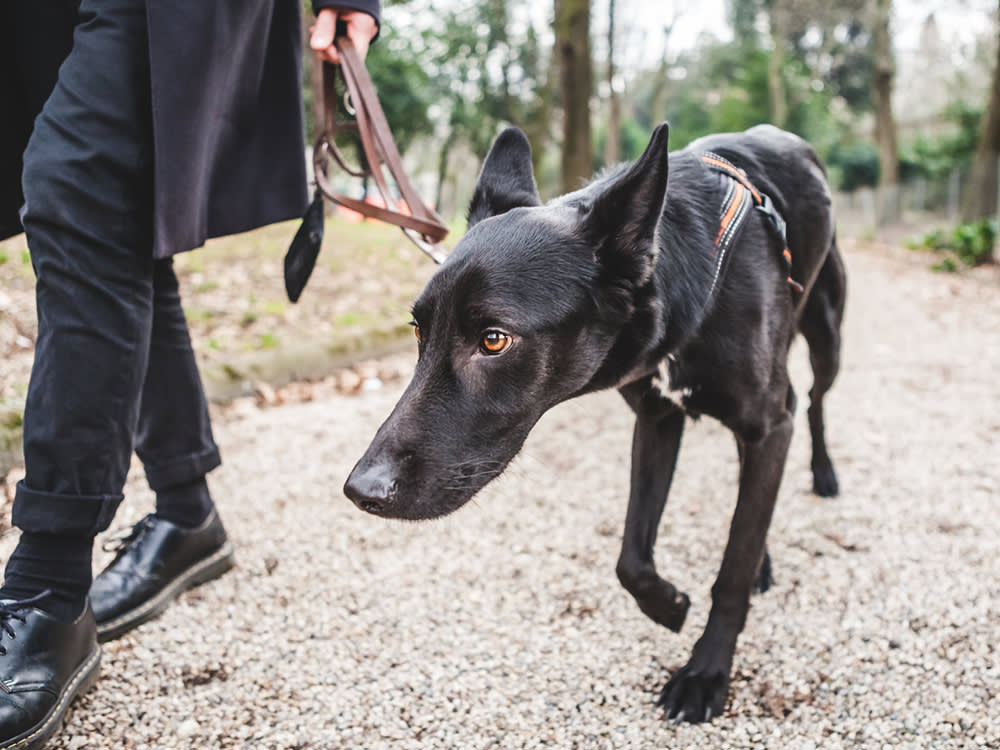
Share Article
For the first month after he was adopted, Sunny spent his time in the corner of one room – where he ate, slept, weed and generally watched the world go by. Murphy whimpered, barked and chewed the carpet whenever she was left alone. Tucker growled and lunged at every man he encountered. Maggie was inconsolable during thunderstorms – pacing, whining, circling, jumping in and out of the bathtub.
All of these dogs have one thing in common: their behaviour problems are a result of fear. But because fear-based behaviour can vary so widely – from cowering under the table when a truck roars by to lunging at and even biting visitors – pet parents don’t always recognise that it is because their dogs are fearful. According to Nicole Wilde, CPDT-KA, canine behaviour specialist and author of Help for Your Fearful Dogopens in new tab, “There are lots of fearful dogs, but people call because of the symptoms. They rarely say, ‘I need help because my dog is fearful.’ They call because their dog is barking at visitors or shredding things.”
How can I tell if my dog is fearful?
These fear-based behaviours don’t improve until the underlying issues have been dealt with. Further, as the fear worsens, so does the problem behaviour. Dr Dan Estep, PhD and Certified Applied Animal Behaviorist (CAAB), notes that, unfortunately, early and perhaps subtle signs of fear – ears pulled back, tail tucked, avoidance – are often discounted as things that all dogs do. If these signs are ignored, the signals may become more obvious and include panting and dilated pupils. Even then, it may be possible to distract the dog from the fear source. But, over time, fearful dogs act more intensely, become harder to distract, and then become destructive or reactive. Only then, when the problem is much more serious and harder to resolve, do people seek help. That’s why it’s so important to recognise the signs of fearfulness in dogs and intervene before the behaviour becomes more difficult to deal with.
According to Dr Estep, “Fears have behavioural, physiological, and subjective components.” Some dogs flee in an attempt to avoid the stimuli that elicit fear; these dogs may hide under the bed or behind their guardian, or simply turn away from whatever it is that frightens them. The appearance of some dogs’ eyes change when they are afraid: the pupils may dilate, or more of the sclera (whites of the eyes) may be visible in an expression known as ‘whale eye’. This may be the result of a dog watching what frightens them by moving their eyes so they can see it without looking at it directly. Or, a dog may scan an area repeatedly in a highly vigilant manner.
Fearful dogs may also adopt telltale body postures: crouching in a lowered body position or lying down and freezing. Many dogs whine, bark or make other distress vocalisations. A fearful dog who is forced to confront or contend with what’s scaring them may become defensively aggressive while still exhibiting signs of fear.
Why do dogs feel fear?
Dogs who are fearful often exhibit many physiological changes, as well: the sympathetic nervous system becomes aroused, which means an increase in heart rate and respiration and possibly shaking, trembling or panting. “No one of these signs by themselves is a reliable indicator of fear or any other emotional state. It’s the pattern of these things together that indicates fear,” says Dr Estep. Both Dr Estep and Nicole note that most common canine fears are related to loud or sudden noises, separation anxiety and unfamiliar people. A fearful dog can be afraid of just about anything new, whether it’s a man in a hat, an umbrella or a buggy.
Just as the behaviour exhibited by fearful dogs can vary, so can the reasons for the fearfulness. This may be because fear is such a common emotion. As Dr Patricia B McConnell, PhD, writes in For the Love of a Dog: Understanding Emotion in You and Your Best Friendopens in new tab, “Surely fear must be the universal of emotions, given its importance to survival. Without it, even civilised urban dwellers wouldn’t live to pass on their genes, because they’d stroll in front of buses and forget to lock their doors at night.”
Dr McConnell’s example is apt: fear serves an important function. Without fear, it would be difficult to recognise dangers to which the appropriate reaction is critical for survival. So, fear is not itself a bad thing. It becomes a problem when individuals of any species, including dogs, are scared or skittish around so many things, or the fear is so intense, that it interferes with their enjoyment of daily life.
Why is my dog so fearful?
We wish we had a straight answer to this question. The reasons that dogs are fearful are exceedingly complex and very difficult to determine for an individual dog, much less for dogs in general. Any pup – purebred or mixed breed, male or female, young or old, rescue or from a breeder – can develop fear-based behaviours. That said, there is compelling evidence that any one of several factors can result in fearful dogs, including genetics.
Genetics
Experiments done with Pointers in the 1960s demonstrated that you can breed for fear of people in dogs. Additionally, many dogs who are fearful have littermates or other relatives with this problem, which suggests a genetic predisposition. It’s hard to tease apart the effects of early experiences and genetics. For example, an entire litter of puppies could also be fearful of people because they were raised with no opportunity to meet them; proper socialisation could have resulted in puppies without such fears.
Lack of socialisation
Socialisation is indeed important: it’s critical to expose puppies to new people, places, animals, sounds, objects and anything else they are likely to encounter throughout their lives. As Dr Estep puts it, “Positive early experiences are critical for preventing fearfulness.” From ages 3–12 weeks, puppies are especially receptive to learning that the unfamiliar is not to be feared.
Pain or underlying health issue
Not all fears develop in puppyhood, however. At age eight, a Miniature Schnauzer named Maxine suddenly developed a fear of other dogs, reacting with barks, lunges and growls whenever a dog approached. She even reacted to her companion dog – a four-year-old Miniature Schnauzer who had been her playmate since being adopted as a puppy. I met Maxine when I was working at a dog camp, and wondered if she was in pain since sudden reactivity at an older age is consistent with the presence of pain. When the camp veterinarian examined Maxine, she discovered inflammation along the dog’s spine and noted that she yelped when that spot was touched. A canine chiropractor treated Maxine, and once her health improved, so did her behaviour. A dog who knows that it is going to hurt when dogs leap on them or play fight with them could react with behaviour that’s intended to make them go away.
Past trauma
Not surprisingly, negative experiences may also lead to fear. For example, a dog who is hit by a car may become afraid of cars. Similarly, a dog who accidentally knocks over a bunch of planks in the garage may develop a fear of any long object such as wood, brooms or shovels or become afraid of the garage.
Can dogs overcome their fears?
The good news for pet parents is that yes, dogs can overcome their fears. The bad news is that it takes a lot of work, patience and understanding. It also requires a high level of proactivity, since these problems rarely resolve on their own. As Debbie Jacobs, CPDT-KA, CAP2, animal behaviourist and author of A Guide to Living with & Training a Fearful Dogopens in new tab, puts it, “Fear is an emotion and changing how a dog, or a person, feels about something is a challenge.” In most cases, professional help from a trainer or behaviourist who uses positive methods is a fundamental part of recovery.
There are so many misconceptions about treating fearfulness in dogs that before discussing what to do, it’s important to know what not to do. Ascribing to any of the following myths is detrimental to progress when working with a fearful dog.
Misconceptions about fearful dogs
Dogs will grow out of it
Expecting a dog to ‘just get over it’ is wishful thinking.
They must have been abused
The behaviour that most commonly elicits concerns of abuse in a dog’s past is that the dog is only scared of men. While it’s possible that a man has harmed the dog, fearful dogs are often more reactive to men than to women or to children, and this is particularly true of dogs whose socialisation experiences were inadequate. It’s likely that men – with their larger size, deeper voices and broader shoulders – appear more imposing to dogs.
They must have had a traumatic experience
It’s natural to assume that a dog who is scared of children has been teased by them, or that the only reason a dog would react badly to a broom is because of a terrifying experience with one. Yes, bad experiences sometimes lead to fear, but often, dogs are afraid of things that are new or unpredictable. So, the dog may fear children because they scream and move around in crazy ways or they may fear brooms because they’re not used to them.
They should be punished
Punishment will make the dog more fearful, and must not be used as a way to change any fear-based behaviour. When bad things happen to a dog in the presence of what scares them, it makes the fear and the problem behaviour worse, not better.
A drug can fix this
In some cases, and always under the supervision of a veterinarian, pharmacological intervention may be appropriate, in conjunction with behaviour modification and other techniques for helping fearful dogs. However, there is no magic pill that instantly cures fearfulness in dogs.
They’re just being stubborn
When a dog refuses to get in a car or crate, resists allowing the vet to examine them, or won’t go down the steps to the cellar, many people perceive their behaviour as obstinate. But with fearful dogs, stubbornness is not the problem, any more than a kid standing on the diving board and refusing to jump is being stubborn.
They’re trying to dominate
Status is a fact of life for many social species, but when dogs are afraid, their social standing is not the issue. Trying to fit all behaviour problems under the heading of dominance does far more harm than good. Happily, more and more people recognise this perspective as outdated and counterproductive.
Petting or consoling them will reinforce the fear
Certified canine behaviour consultant Pia Silvani’s comment on this common misconception is simple: “With all due respect, this does not make a bit of sense.” It is OK to reassure your dog that everything is fine in a calm and confident manner. To ignore them when they are clearly distressed is about as logical as refusing to hug your child when they wake up from a nightmare. They are not going to become more fearful when they are reassured, but failing to do anything risks teaching them that you are not available when they need you most. Nicole tells her clients, “Be affectionate with your dog, but if you are overly worried, your dog will be, too. It’s fine to reassure your dog casually with an upbeat tone, but don’t coddle them with nervous energy.”
You just have to live with it or get rid of the dog
Thankfully, this is not true, but resolving a dog’s fear-based problem does take effort. “It’s not easy and it never happens as quickly as you’d like it to. It’s going to require more work, time and energy than you anticipated,” says Debbie. Many dogs recover completely, and still others improve greatly, though they may always remain on the cautious side; some situations may always be overwhelming and should be avoided.
So, how can I help my fearful dog?
Part of working with a fearful dog involves accepting that it’s hard to know how far a particular dog can go in overcoming the problem. If a pet parent expects that any dog can become happy-go-lucky, extroverted and confident, they may be disappointed in the future. As Debbie writes, “Changing our own views, beliefs and expectations may be the first step the parent of a fearful dog needs to take.” To help a dog overcome fear, it is often most effective to combine several basic strategies.
Visit your veterinarian
The first step should be a thorough medical evaluation to determine if health problems are playing a role. Dogs who are in pain may develop fear of anything that exacerbates the pain, such as being touched, being approached by a playful dog, a lead or collar or a sport class like agility. Older dogs may develop fears and phobias following physical changes, including cognitive deterioration or loss of sight or hearing. A myriad of other physical problems can be in play as well, and any underlying medical issue should be resolved.
Do all you can to protect your dog from frightening situations
This may involve being an advocate for your dog, such as stopping strangers from stroking them or refusing to let a family member use power tools until you get the dog out of the house. Management of the environment is a lot of work, but it’s work that pays big dividends. Protecting a dog from exposure to situations that scare them is a great way to start, because every time a fearful dog becomes afraid, the problem is compounded.
And as Jaak Panksepp, neuroscientist, psychobiologist and author of Affective Neuroscience: The Foundations of Human and Animal Emotionsopens in new tab, says, “One of the most horrible experiences of life is to be stricken by sudden terror. Another is to be continually consumed by the persistent feelings of anxiety that gnaw away at you, destroying your sense of security in the world.” For dogs who are reactive to the point of snapping or biting, preventing situations in which the dog feels the need to do this is essential for the safety of others as well as for the well-being of the dog.
Never force your dog to approach something that scares them
It’s not going to help, and it may make the situation worse, adding yet another scary experience that confirms your pup’s belief that something is worth being afraid of. Nicole advises that we allow the dog to make the decision about approaching or avoiding a potentially scary situation.
Help your dog develop confidence
Developing your dog’s confidence can help them overcome their fearfulness because these two states of being are not compatible. Anything that allows a dog to experience success is good for their self-esteem and adds to their self-assurance. Training dogs to perform behaviours on cue – standard obedience exercises, targeting, responding to their names or performing tricks – can build confidence.
So can getting their nourishment from food-reward puzzles or food-stuffed toys because accessing the food is an accomplishment. Play is also a way to help dogs feel confident. Once a fearful dog is comfortable enough to happily engage in play, a positive feedback loop develops. The more they play, the more confident they are, and the more confident they are, the more they play.
Practice desensitisation and classical counterconditioning
These techniques are often the core treatment for fearful dogs. Systematic desensitisation is a structured way of repeatedly exposing your dog to something that they fear, but starting at a low level so that fear is not induced. Then, gradually, during many sessions over a period of weeks, months or even years, the intensity of what frightens them is increased so that they can get used to it at each level before moving on to the next. Scary things are made less scary by being smaller, slower, quieter, farther away or otherwise less intense. Exposing your dog to what frightens them at an intensity level that is too low to induce their fear is completely different than forcing them to confront what they fear by overdoing it and actually scaring them. (For details on these techniques, Patricia B McConnell’s booklet, The Cautious Canineopens in new tab, is a great resource.)
Classical counterconditioning consists of pairing up what frightens the dog with something the dog loves more than anything else; eventually, the dog realises that the scary thing predicts the wonderful thing. If your dog fears people, then every time they see someone, they should immediately receive their favourite treat or highly prized toy or other item. Eventually, the dog will have a positive emotional reaction to seeing a person, because they know that something good is about to happen. Exposing your dog to the trigger that scares them, starting at very low levels of intensity and gradually working up to more intense exposures, is most effective. In practice, desensitisation and classical counterconditioning are often done together.
Some dogs progress rapidly, but others make progress that can only be detected when viewed long-term, over years or perhaps over the dog’s entire life. No matter which pattern describes your dog, it’s important to work gradually, and as Nicole says, “Go at the dog’s pace.” You must only move to more intense triggers when the dog is clearly comfortable at the previous level of exposure. Fearful dogs must be handled carefully and with endless patience.
Build a good foundation
Most behaviourists and trainers agree that in addition to specific behaviour modification, a good foundation for helping dogs overcome their fears is built from many aspects of their daily life. Good nutrition, regular exercise and predictable routines are all helpful. Other potentially calming, therapeutic techniques or alternative therapies include massage, anxiety wraps, Bach flower essences, homeopathic remedies, acupuncture and Traditional Chinese Medicine.
How much will my dog improve?
Almost all fearful dogs can improve, but the degree to which a dog overcomes their fear depends on many factors. Dr Estep and Nicole agree that the human partner is a huge factor in the eventual outcome. Motivation is critical for success, as is an understanding of the situation and the amount of time the person is willing to commit to it. The use of gentle, positive methods is also linked with improvement. Mild fears or those of recent development have a higher likelihood of successful resolution. The dog’s genetics play a role as well; the stronger the genetic component of the dog’s fears, the harder it may be to overcome them.
Nicole sums up the basic approach to helping fearful dogs: “It takes time and patience. Always be gentle, positive and kind. Never, ever use physical force or corrections.” Debbie echoes this advice: “Your dog’s trust in you is the most important building block in the foundation for building their confidence. Never use any type of punishment or correction which scares or intimidates your dog.”
Though it can be gut-wrenching to watch a dog live in fear, there are also positive aspects, and that may be part of the reason why some people are drawn to fearful dogs. Nicole has a long-standing history of relating to them. “I always had an empathy for the fearful ones. I was drawn to the shaking dog in the corner.” She points out that having a fearful dog “teaches you a lot about subtleties of canine body language. You become tuned into your dog. You learn to manage things. You gain increased empathy for your dog. You expand your knowledge and patience.”
Helping a dog who lives in fear is a common undertaking; many pet parents, knowingly or not, end up living with a dog who is afraid. To succeed in treating a fearful dog so that they can conquer their fears requires knowledge, consistent effort and extraordinary patience. It’s not easy, but it’s gratifying to see the difference in a dog who has been the beneficiary of this hard work. While it is an experience that is likely to have lows that are lower and highs that are higher than expected, many pet parents report that it is immensely rewarding to work with their dogs and help them overcome their fears. As though we needed further convincing that dogs of all types, including the fearful ones, enrich our lives.
Final takeaway: 10 things to remember if you have a fearful dog
Be patient – it can take a long time for dogs to overcome their fears.
Commit to helping your dog by putting in the time and effort to treat their fears.
Don’t force your dog into situations that you know induce fear.
Be open to the variety of techniques that may help your dog conquer their fears.
Handle any relevant medical issues.
Be gentle, positive and kind.
Never use punishment.
Protect your dog from scary situations.
Accept that many fearful dogs never become gregarious, go-with-the-flow types.
Love your dog for who they are.

Karen B. London, PhD, CAAB, CPDT-KA
Karen B. London, Ph.D., is a Certified Applied Animal Behaviorist and Certified Professional Dog Trainer who specializes in working with dogs with serious behavioral issues, including aggression, and has also trained other animals including cats, birds, snakes, and insects.
Related articles
![A happy looking man and woman walking their dog outside in a large snowy field.]()
10 Ways to Make Your Dog’s Life Better
Simple resolutions to boost your dog’s happiness, health and well-being all year long
Reverse Sneezing in Dogs: Causes and Treatment
Don’t panic! In most cases, it’s nothing to worry about
![Dog looking at their shadow in the snow]()
“Why Is My Dog Obsessed With Chasing Shadows?”
A fascination with lights and shadows is common in high-energy dogs – but it can develop into obsessive-compulsive disorder if it gets out of hand
![Dog hiding under the sofa and afraid to go out because he heard fireworks.]()
Why Are Dogs Scared of Fireworks?
How to keep your dog mentally and physically safe this Bonfire Night

